Mobile apps are everywhere. Your pocket-sized assistants are for everything from shopping and banking to entertainment and education or fitness tracking. But here’s the catch: Developing a great mobile app isn’t just coding and uploading it to the App Store or Google Play. Nope, it’s a battleground of mobile app development challenges and solutions.
Developers often encounter numerous challenges that can hinder an app’s success if not addressed properly. Studies show over 80% of mobile apps are abandoned after just one use. Why? This article explores ten critical mobile app development challenges and offers effective solutions to overcome them.
1. Poor UI/UX Design
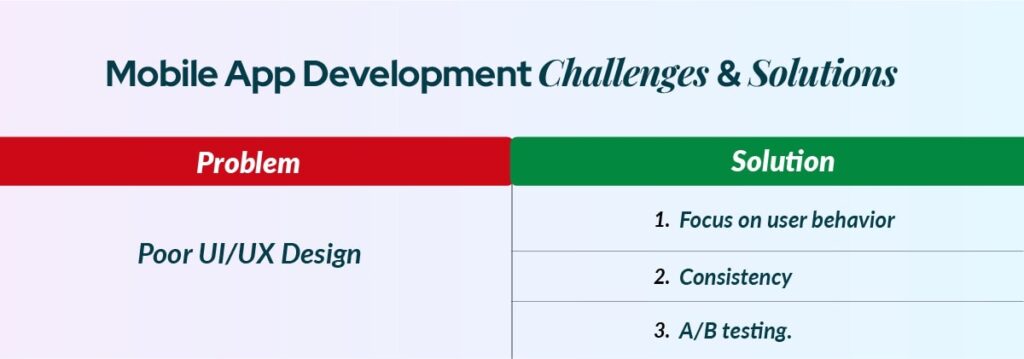
A mobile application’s user interface (UI) and user experience (UX) are essential to its success. An app with a cluttered interface or confusing navigation can frustrate users, leading to uninstalls and negative reviews. A study highlights that UI/UX design is a significant challenge in mobile app development.
Solutions to Poor UI/UX Design
There are many solutions to poor UI/UX Design. Try these features to ensure you act perfectly when developing a user-centric mobile app.
User-Centric Design
Prioritize the needs and preferences of your target audience. Conduct user research to understand their expectations and pain points for providing a user-centric design. You can use heatmaps and user behavior analytics to study how people interact with your app.
Consistency
Uniformity in design elements like buttons, fonts, and colors throughout the app should be maintained to provide a cohesive experience. Design systems like Material Design or Apple Human Interface Guidelines should also be followed to ensure consistency.
Feedback Mechanisms
Add features that allow users to provide feedback, which leads to continuous improvement for UI/UX design.
Run A/B Test
Run A/B tests on interface layouts to determine what clicks with users. Then, according to the user’s behavior, take the necessary steps.
2. Performance and Speed Issues
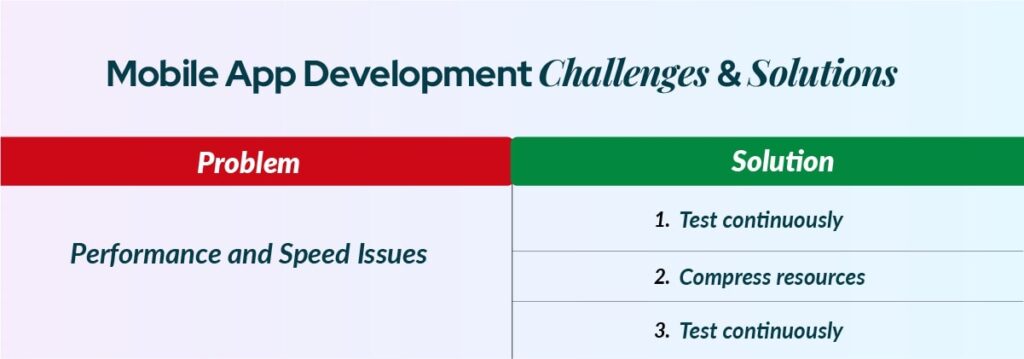
Users expect apps to be fast and responsive. Slow load times or laggy interfaces can lead to user dissatisfaction and abandonment. According to Tri-State Technology, performance optimization is a pressing challenge in mobile app development.
How to Optimize Performance and Speed for Mobile Apps?
If you know how to optimize the performance and speed of your mobile apps, it will be easier to attract more users. Here’s what you can do to achieve these?
Efficient Coding Practices
Optimize code to reduce load times and improve responsiveness.
Resource Management
Compress images and minimize the usage of heavy animations and lazy-load heavy content to ensure smooth performance.
Regular Testing
Conduct performance testing to identify and address bottlenecks before deployment. Profile your app using Firebase Performance Monitoring to detect lags.
3. Security Vulnerabilities

With the increasing amount of personal data stored in mobile apps, security issues have become a top challenge in mobile app development. Data breaches can lead to loss of user trust and legal complications.
How to Overcome Security Issues for Mobile Apps?
But if you don’t follow mobile app security best practices, you’ll be in deep trouble. How can you ensure the security system works properly?
Data Protection and Encryption: Make sure your app is GDPR compliant, especially if you’re dealing with users in the EU. Use SSL/TLS encryptions to protect user data during the transmission and storage.
Secure Authentication: Multi-factor authentication adds an extra layer of security. To seal the deal, implement OAuth 2.0.
Regular Updates: Keep the app updated to patch vulnerabilities and address emerging security threats.
4. Backend Scalability Issues
As the user base grows, the app’s backend must handle increased loads without compromising performance. Scalability challenges can lead to crashes and downtime.
Solutions to the Backend Scalability Issues
If your developed mobile app is crashing, glitching, or slowing down because the backend can’t keep up, follow these to overcome the issue:
Cloud Services: Utilize cloud solutions like AWS, Google Cloud, or Firebase scalable infrastructure to accommodate growth.
Load Balancing: Implement load balancers to distribute traffic evenly across servers, ensuring stability.
Modular Architecture: Design the backend with modular components to facilitate easy maintenance. Break your backend into microservices so each part scales independently.
5. High Development Costs
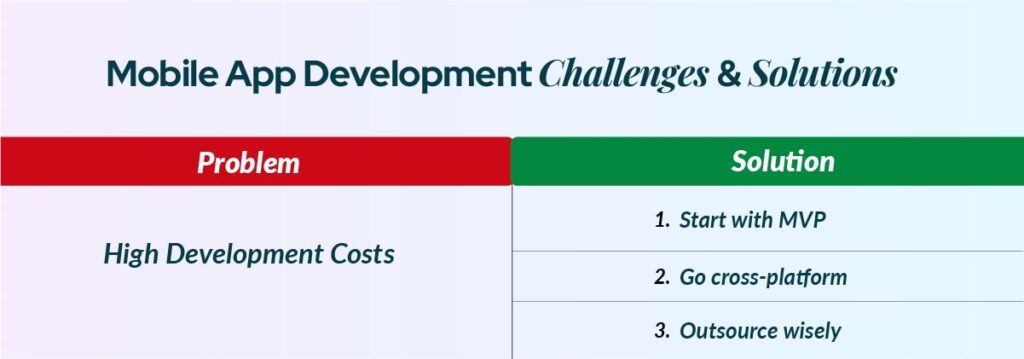
Mobile apps can cost anywhere between $30K and $300K. Developing a feature-rich mobile app is costly for startups and small businesses. Everything from hiring a skilled team to building for multiple platforms adds up.
How to Overcome High Development Costs?
Let’s break down smart, practical ways to keep your mobile app development budget in check while still building a product users will love.
MVP First: Start with a Minimum Viable Product (MVP). Focus on core features to test your app idea before investing more.
Cross-Platform Development: To cut costs, use frameworks like Flutter, React Native, or Xamarin to build one codebase that works on both iOS and Android.
Outsource Smartly: Consider hiring experienced offshore development teams that can reduce costs without sacrificing quality; ensure they follow best practices.
6. Cross-Platform Compatibility
Users are everywhere on iPhones, Android tablets, and even smart TVs. Your app needs to work seamlessly across devices and screen sizes. This is a real challenge in mobile app development that many overlook until it’s too late.
How to ensure Cross-Platform Compatibility?
Compatibility issues cause bad UX and negative reviews. Here’s how to ensure your app works effortlessly everywhere.
Responsive Design: Use flexible layouts and scalable elements so your UI adjusts to different screens. Test with tools like BrowserStack or Sauce Labs.
Universal Testing: Test your app across various devices, operating systems, and screen sizes before launch.
Use Cross-Platform Tools: Tools like Flutter or React Native ensure consistency in user experience without needing separate native apps.
7. Integration with Emerging Technologies
Each technology comes with its own set of requirements, frameworks, and compatibility issues. Integrating advanced tech like AI, Augmented Reality (AR), Chatbots, or the Internet of Things (IoT) can add serious value. If not done right, integrations can lead to bugs, performance issues, or even app store rejection.
What are the Integrations to Comply with Technologies?
Let’s explore the best ways to make your app future-ready through smart tech integrations.
Modular Integration: Don’t try to do it all at once. Add emerging tech as separate modules that can be tested and improved independently.
APIs and SDKs: When integrating new technologies, use verified, well-documented APIs and SDKs to avoid reinventing the wheel. TensorFlow Lite and Dialogflow are the best third-party APIs for reducing dev time.
Stay Updated: Emerging tech evolves fast. Keep your dev team in the loop with training and regular updates on industry standards.
8. App Store Approval and Compliance
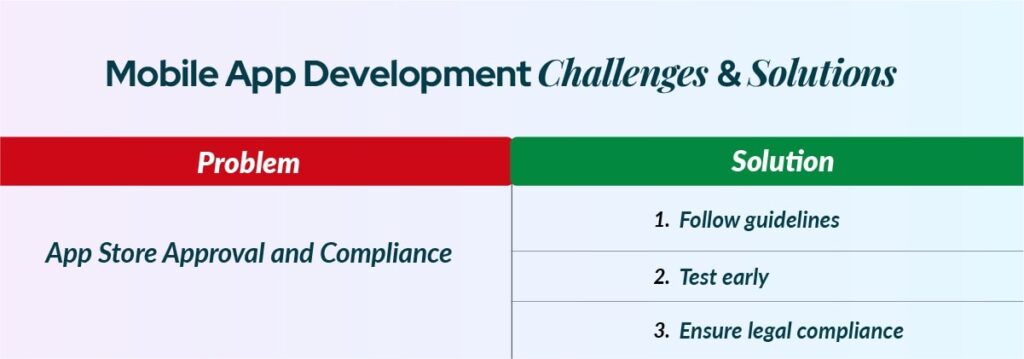
You’ve built the app. It’s perfect. But wait. Apple or Google Play just rejected it. Approval isn’t guaranteed, and getting listed means playing by their rules.
How to get App Store Approval and Maintain Compliance?
To avoid costly delays and rejections, developers need a solid understanding of what the stores expect and how to comply with evolving policies. Here’s how to navigate the process and keep your app in good standing.
Follow Guidelines: Each store has detailed developer policies. Stick to them like glue during development.
Beta Testing: Use internal testing tools (like TestFlight for iOS) to find and fix compliance issues before submission.
Legal Compliance: Ensure your app meets data protection regulations like GDPR and CCPA if you’re operating in those regions.
9. Effective Testing and Quality Assurance
No matter how sleek your design or how advanced your features are, if your app is buggy, slow, or unstable, users will delete it in a heartbeat. Even one crash can destroy your reviews. And with so many device types, skipping testing is a risk you can’t afford.
How to Test Effectively and Assure Quality?
Let’s explore how to test smart, catch issues early, and deliver a rock-solid user experience.
Automated Testing: Run tests automatically for every update to catch common issues fast. Automate testing with Appium and integrate with CI/CD pipelines.
Manual Testing: Some things still need the human touch, like visual layout, usability, and real-world performance. Collect the real-world feedback via TestFlight or Firebase Test Lab.
Beta Groups: Recruit real users to test your app in the wild before public release.
10. Continuous Maintenance and Updates
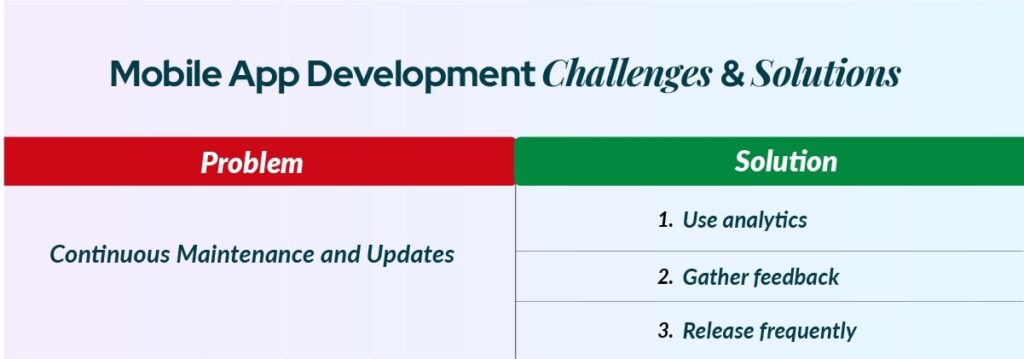
Development doesn’t end at launch. New OS updates, user feedback, and tech trends all demand that you keep evolving.
How to Maintain and Update Continuously?
Regular Updates: Fix bugs, enhance features, and stay compatible with new devices.
Feedback Loops: Let users report issues directly from the app to prioritize updates. Use Firebase Crashlytics to catch crashes in real time.
Analytics Tools: Use data tools like Firebase, Mixpanel, or AppDynamics to monitor performance and behavior.
Conclusion
Mobile app development challenges and solutions go hand-in-hand. Yes, building a successful app can be tricky. But if you follow mobile app development best practices like starting small, testing often, and putting users first, you can overcome nearly every obstacle.
From UI issues to backend chaos, performance dips, and compliance hurdles, each problem has a fix. You just need the right strategy. Contact us to learn the right strategies to meet your needs.
And here’s the secret sauce: stay flexible. Trends change, tech evolves, user needs shift, and the best apps grow. So take these solutions, apply them smartly, and go build something people love to use.
FAQs
Why is mobile development difficult?
Mobile development involves juggling many moving parts, such as UI design, backend architecture, performance, platform differences, and user behavior, while staying within budget and hitting deadlines.
What are the best practices for mobile app development?
Start with MVP, use agile methodologies, prioritize UI/UX, conduct thorough testing, ensure security, and collect continuous feedback for updates.
What are common mobile app problems and solutions?
Problems include bad design, slow speed, high costs, and lack of security. Solutions involve user-focused design, cross-platform tools, scalable cloud services, and secure coding practices.
Why do mobile apps fail?
Most apps fail due to poor planning, weak user engagement, technical issues, bad UI/UX, or a lack of post-launch updates.
How can I ensure my mobile app is scalable and future-proof?
To ensure mobile apps are scalable and future-proof, use modular architecture and cloud platforms, monitor performance continuously, and stay up-to-date with industry trends and OS changes.











